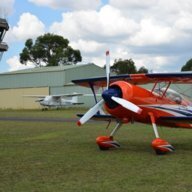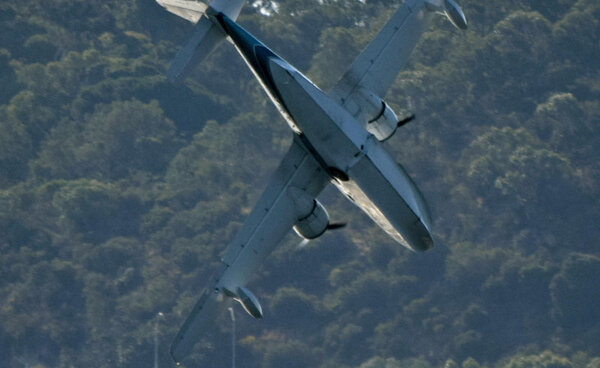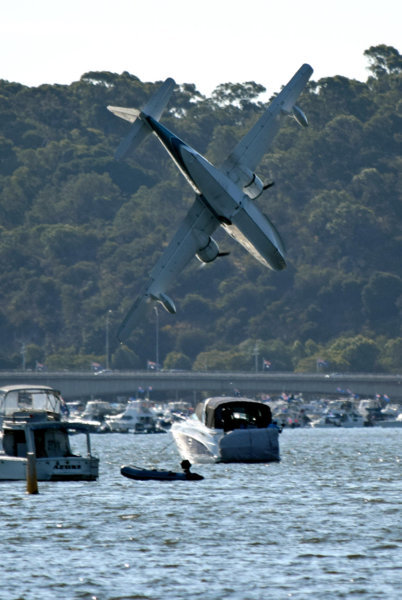-
Posts
1,201 -
Joined
-
Last visited
-
Days Won
21
Content Type
Profiles
Forums
Gallery
Downloads
Blogs
Events
Store
Aircraft
Resources
Tutorials
Articles
Classifieds
Movies
Books
Community Map
Quizzes
Videos Directory
Everything posted by dutchroll
-

Rex aircraft losses a prop mid-flight
dutchroll replied to planedriver's topic in Aircraft Incidents and Accidents
Needless to say a propeller shouldn't come off in flight due to metal fatigue or any other cause. We used to operate 40 year old C130s with high hours in the RAAF and a prop never came off. They'll obviously be casting a pretty critical eye over maintenance records and that propeller's history. -
You get some pretty heated arguments in politics, but you start allowing posts on Fords and Holdens.........well........don't say I didn't warn you!
-
I know there are a wide variety of people in the recreational flying community, but......
-
Some years ago we had a RAAF C130H overseas which developed an aileron trim tab electrical fault. A miscommunication between base engineering here in Oz and the crew resulted in the aircraft taking off with the aileron tab physically disconnected from the motor shaft and drifting freely in the airflow (they were meant to disconnect the electrical side only, with the tab frozen in a neutral position and motor inoperative). Shortly after takeoff they experienced severe flutter and vibration through the whole aircraft, significantly hampering controllability. They slowed right down and returned for an immediate landing. Popular opinion is that they were very lucky. You have to be real, real careful what you do with flight controls!
-
Some people use this B52 example to suggest loss of the vertical stab is not the end of the world (they landed successfully) but they neglect to point out that it does actually have just enough left to give it some longitudinal stability. Also there were several other cases of B52s losing their vertical stabs, all of which resulted in the aircraft crashing. Also the loss of American Airlines AA587 in New York some years back was directly caused by the complete loss of the vertical stab, making the aircraft uncontrollable. It broke off due to the First Officer's aggressive overreaction on the rudders after entering wake turbulence behind a B747 (to maintain control in wake turbulence you don't actually need to use the rudder at all - just the ailerons). His rapid alternating full rudder deflection left and right overstressed the vertical stab to double its design limit loading, causing it to completely separate.
-
I think for the sake of semantics, the original post was about "loss of control surface" and should be taken to mean the complete loss of use of that control surface. Many types of trim systems will of course enable the deflection of a control surface through trimming even if the link to the pilot's control column or yoke is not operating. So in those cases you get some degree of controllability, which is not the point of the original question. So back to where we were - the complete loss of elevator control makes for a very tough time controlling the aircraft (ie - one which has conventional flight controls). Far more so than loss of aileron or rudder (note: loss of rudder does not imply loss of the entire vertical stabiliser in aircraft of conventional design, which makes retaining control highly improbable).
-
Rudder? Crikey. In my day job the rudder pedals are merely footrests (except for takeoff and engine failure)! I'm admittedly guilty of not using it enough on my fun-plane too. When I was in the RAAF I did some experiments in the C130 full flight simulator and total loss of elevator control (including elevator trim) resulted in the most difficulty retaining control of the aircraft. However with some deft use of power and a bit of forethought, the aircraft could still be landed by an experienced and well-trained pilot with any one control surface unusable. Unusable control surfaces in more than one axis required some fairly fancy flying due to phugoid oscillations coupled with rolling or yawing, and depending on the circumstances does not always end well.
-

Encroaching Suburbia on Airfields
dutchroll replied to Cosmick's topic in Aircraft General Discussion
People getting all uptight about encroaching development at airports here in Australia really need to get out and see more of the world's city and municipal airports! There are not many places near cities I know of that failure to climb away on one engine is going to allow the plane to be crashed onto a nice grassy field. Try looking up a few on google earth...... -

A human factors experience
dutchroll replied to pmccarthy's topic in Aircraft Incidents and Accidents
^^ That's the crux of what happened right there in that statement. We are quite used to acute fatigue in the airlines. The difference is that we don't operate single pilot, we strictly use checklists for almost everything, and we have a lot of warning systems which won't let us do anything silly. So we have a number of risk-mitigators which are not necessarily present in the sport aviation world. Even so, there are several bad accidents where fatigue has been a factor and I'd be lying if I told you we never fly fatigued. However we are also allowed to take short naps in flight if this is the case, while the other guy flies, until we get to the other end and can get a decent night's sleep in the hotel. No such luxury when you're single pilot. You can be fatigued like this but get the false impression you're ok as you walk out to the plane and get a bit of an adrenalin kick on the way. Fatigue is cumulative and you can't make up several nights of poor sleep with an afternoon nap or a coffee. You need a couple of nights of solid good quality sleep to recharge and until you get that, the fatigue will hang around with all its potential consequences. -
If you think that's a bit of a run-around, try getting a CASA temporary licence issued to a visiting foreigner. I had a guy come over a couple of years back to test fly my aircraft and do some transitional training. He had an FAA licence and a huge number of hours on type. That process was a nightmare. The worst bit was that CASA refuses to recognise the FAA "english language certification" because the wording on the FAA licence is slightly different to the ICAO wording, so I had to pay for him - a born and bred American citizen - to be certified competent in English despite him already being certified as such on his FAA licence! The guys who did the language testing thought it was a joke! The whole licensing process was a nightmare. If I had to do the same again I would forego that whole process and simply take him on the test flights as a "required observer" while he gave instructional feedback with myself as "PIC", because I already technically have the correct endorsements.
-
Yeah that's crap and most likely CASA having one of their bureaucratic "blonde" moments. JPs most certainly are allowed to certify identity document copies. Their signature block should include their name and qualification. They will also be listed on the state government website in the register of JPs. A "please explain?" to CASA would be worthwhile.
-
You answered your own question Phil. This is the country where, when my wife was working there, she asked a colleague why he bothered always carrying a concealed loaded handgun - even when walking the dog around the block. His answer? "Because when I was a kid, I once had my lunch money stolen by bullies on the school bus." Yes, seriously. You never know when you might need a Glock to blow away a pesky 12 year old.
-

Air Charter crashes at Essendon
dutchroll replied to red750's topic in Aircraft Incidents and Accidents
I hit a boundary fence post with my tractor once. It wasn't in the correct spot as per the boundary survey. I never thought of suing the fencing guy for the damage. -

Air Charter crashes at Essendon
dutchroll replied to red750's topic in Aircraft Incidents and Accidents
I have visions of the relatives of a hypothetical family suing a council after they get killed when the front tyre of the car blows and they crash into a concrete culvert off to the side of the road. "Well if the council hadn't built the concrete culvert there, they might not have died." What a can of worms that type of litigation will open. -

Air Charter crashes at Essendon
dutchroll replied to red750's topic in Aircraft Incidents and Accidents
So......you're trying to prove that people who allowed a building (not even a tall one) to be put somewhere in the vicinity of an airport (but not even on the direct flight path) were negligent, causing the death of passengers in a plane which crashed into it? Well......hats off to the law firm which manages to succeed with that one. -

Air Charter crashes at Essendon
dutchroll replied to red750's topic in Aircraft Incidents and Accidents
Has anyone actually determined that the building infringed the designated obstacle clearance plane of the departure runway? Because I've seen a map showing the flight path of the aircraft and it seems unlikely to me. If we then want to say "well all airports should have big cleared zones free of buildings or infrastructure just in case a twin engine aircraft with an engine failure certified to climb away on one engine can't do it and has to crash land instead" then you will shut down most major big city airports around the world. Sullenberger would've crashed into the streets of New York in his A320 had there not happened to be a big river running through there. -

Air Charter crashes at Essendon
dutchroll replied to red750's topic in Aircraft Incidents and Accidents
"Because the building they hit was there" is not a useful finding of cause of death. -

Air Charter crashes at Essendon
dutchroll replied to red750's topic in Aircraft Incidents and Accidents
Wasn't a journo. It was a very uneducated member of the public. I'm not sure which is worse sometimes! -

Air Charter crashes at Essendon
dutchroll replied to red750's topic in Aircraft Incidents and Accidents
The B200 King Air comes standard with an autofeather system. The B200 should also be able to climb away with the gear up and one prop feathered at max weight (unlike smaller less powerful twins where the 2nd engine will just carry you to the scene of the accident). It's not lacking power on one engine, so that will be something the investigators will need to look at. Why did it fail to achieve this? Public commentary has of course ranged from reasonable to mind-numbingly stupid. As an example of the latter, I present to you this comment on the 7 News FB page and my response to the guy: Commenter: "The onus is on the pilot to check the plane before each flight to make sure everything is working properly, and to either not fly it until it's repaired or to commence repairs themselves if able to do so. Therefore, portioning blame onto the pilot is quite acceptable as he either didn't perform these checks or ignored potential safety issues." My response: "So.....is it normal that your icy cool stare at a piece of complex machinery just scares it into submission and makes it keep working forever?" -

Aircraft incident Nanneela Vici
dutchroll replied to tillmanr's topic in Aircraft Incidents and Accidents
Well that journo is clearly going nowhere in their career........ -

CASA medical Standards Discussion Paper
dutchroll replied to Mike Borgelt's topic in AUS/NZ General Discussion
A bit of a typo there (edited by mod) He was undiagnosed. As explained by Jaba above, he had a hyperglycaemic moment (blood sugar too high), not a hypoglycaemic (blood sugar too low) moment. -
I know what Perth is like - I spend half my life flying in and out of it - but I honestly don't care who has done the most approaches. He was filmed maintaining a roughly level, tight-ish turn over the Swan River until the point control was lost. If you can explain how that'll put you in undershoot shear I will have learned something today. Why on earth would I do that? I'm not trying to substitute myself for the investigation. I'm simply stating observations and suggesting a highly probable cause. Yes, that could be wrong, but if you're a qualified accident investigator you'll know there are very few accidents worldwide fitting this description and set of circumstances which are not simply "pilot lost control of aircraft with insufficient altitude to recover". There may be contributing factors of course. By the way, yesterday an ATSB spokesman stated they already "had a good idea of the crash cause" - and they haven't done a detailed wreckage examination yet. Their words, not mine.
-
How would the flight path of the aircraft as depicted have taken him into low level windshear? There's a lot of opposite (right) aileron in there, and no rudder. As I said earlier, instinctive, but very detrimental if the aircraft is stalled. If it was a left engine failure the immediate application of right rudder would be expected too, as any multi-engine pilot would know. Yet there is none.
-
The wing drops because it stalls before the other one. If you then apply opposite aileron in an attempt to correct the roll, you are applying "down" aileron on the low wing. This further increases the angle of attack of that already stalled wing, making the problem worse. The aircraft will by this time be yawing in the direction of the low wing. You are now entering spin territory (but not quite actually in it). You don't necessarily want a "full boot load". You want enough to prevent the nose yawing any further. That might be a small amount, or it might be a lot. Either way, you want to "stop it getting worse". These actions are done after the immediate initial actions for stall recovery. In very quick succession you therefore need: 1. Simultaneously apply full power and lower the nose (ie, release the back pressure) 2. Apply rudder to prevent further yawing (ailerons neutral) 3. Level wings and recover. In this case I agree with commenters that his altitude was such that it very quickly became unrecoverable. He would've had to recognise the incipient signs of a stall and initiate recovery quite early. I suspect there was a second or two of "startle factor" there which is all that's needed for a tragedy if you've got no altitude.
-
Most likely a consequence of this...... One other thing I didn't mention previously was that in a wing-drop stall situation like this appears to be, the instinctive reaction is to apply opposite aileron, which will generally make the situation rapidly worsen. It's good to practice stalls like this at a safe altitude in aircraft prone to it so you learn to quickly recognise it (the Winjeel could violently drop a wing in a turning stall). On aircraft not prone to it, it's good to see the resistance of that aircraft to wing drop too. Obviously with an instructor until you're proficient and confident enough to practice yourself (if you want to do that).








